We’re leaving Hebden Bridge in Yorkshire and heading to Birmingham for the next couple of days. Tomorrow I will be a panelist on the Rhubarb-Rhubarb seminar ‘The Value of the Image’. If you’re going, please be sure to say hi afterwards.
Here are the details-

RHUBARB-RHUBARB PRESENTS THE VISIONARY ‘TALKIN’ BUSINESS’ SEMINAR
with
Alison Nordstrom – Curator of Photographs at George Eastman House International Museum of Photography and Film in Rochester, New York
Stephen Mayes – International Image Forecaster, New York
Simon Roberts – Award Winning Photographer, Brighton
Conceptualised and chaired by Rhonda Wilson – Creative Director, Rhubarb-Rhubarb
Three remarkable people with a wealth of experience in the fields of Fine Art/Documentary/and Commercial/Stock photography discuss The Value of the Image at a time where technologies and economics are inextricably bound up in the futures of emerging and mid career photographers, and the ability of those already ‘up there ‘ to remain so.Â
Far from simply being a question of producing ‘good’ images, the demands on photographers – to be smart in business and savvy in protecting themselves and their images from real time and virtual exploitation, keeping their agents happy, selling work and finding the resources to finance new projects – are the harsh realities for anyone wishing to stay alive in the increasingly complex ladder of opportunity within the image sector.
In this fascinating seminar, Simon Roberts gives a contemporary account of the skills involved in becoming and remaining an international photographer of repute; Alison Nordström will discuss the acquiring and caring for work in perpetuity – how working with museum collections is fundamentally different from working with sales galleries, temporary exhibitions or alternative spaces and Stephen Mayes will be predicting the future with the demise of copyright and the rise in the value of the web for selling ideas.
Thursday 31st July 2008 at 1pm
Lecture Theatre, Aston Business School, Aston University, Aston Triangle, Birmingham B4 7ET
£30 , £25 concessions and Rhubarb Review attendants– booking essential –
please email info@rhubarb-rhubarb.net to reserve a place
Â
Posted in MISCELLANEOUS | Comments Off on RHUBARB-RHUBARB SEMINAR
This was a question posed by Dr John Sentamu in a speech he made before his enthronement as Archbishop of York in November 2005. He answered-
“It is a very serious question. The English are somehow embarrassed about some of the good things they have done. Multiculturalism has seemed to imply, wrongly for me, ‘Let other cultures be allowed to express themselves but do not let the majority culture at all tell us its glories, its struggles, its joys, its pains’. A failure to rediscover English culture would fuel greater political extremism.”
You can read the full speech here.
Â
Posted in ENGLISHNESS | Comments Off on WHAT IS IT TO BE ENGLISH?
Continuing my weekly dispatch in The Times, week 9 was taken in New Brighton, Merseyside.
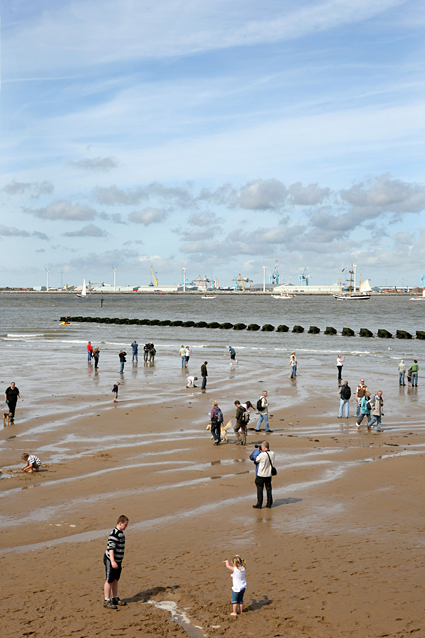
New Brighton, 21st July 2008
Spectators gather on New Brighton beach as the last of the Tall Ships sail out of Liverpool on the River Mersey. Over 60 sailing ships were moored in the city’s docks for the start of the annual Tall Ships Race, creating scenes reminiscent of Liverpool’s historic past.
Â
Posted in EVENTS & PASTIMES, POSTCARDS | Comments Off on POSTCARD IN THE TIMES – WEEK 9
I enjoyed this cartoon in today’s Times by Morland showing an embattled Prime Minister, Gordon Brown holidaying in Southwold, Suffolk.
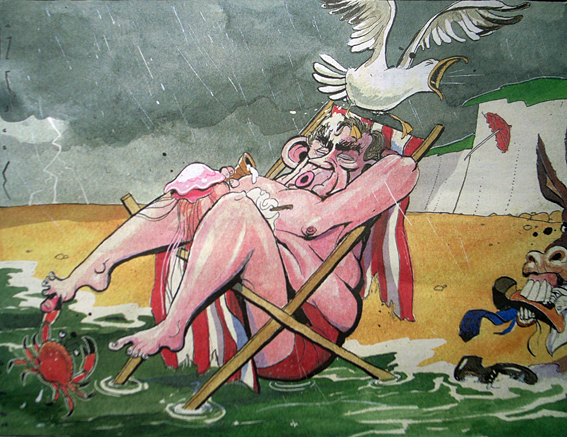
Â
Posted in MISCELLANEOUS | Comments Off on BROWN IN SOUTHWOLD
Jemima and I take a Monday-morning dip in Malham Tarn, Yorkshire Dales.

Â
Posted in Uncategorized | Comments Off on BATH TIME
So the humble postcard is back in fashion having survived the internet age, emails and e-cards. This month Royal Mail announced soaring sales of postcards with 135 million being sent last year – an increase of 30 million on five years ago.
According to an article in The Guardian today, the postcard boom began around 1900, thanks to two developments- improved printing methods combined with reduced postal charges – and 419 million were sent that year. This had doubled by 1918. Mostly, then as now, people sent cards from their holidays. Proof that they were there, showing off their good times. It’s become an inherited tradition.
Blackpool, the popular coastal resort in Lancashire, has had a rich association with the postcard. Mainly thanks to Donald McGill a graphic artist (and respectable Victorian gentleman) who created the smutty postcards sold mainly in small shops in British seaside towns. Between 1904-1962 McGill produced an estimated 12,000 designs of which an estimated 200 million were printed and sold. In 1939, one million were sold by one Blackpool shop alone! His postcards even came under the scrutiny of the Conservative government in the 1950s.
Here are a few contemporary postcards I came across in Blackpool this weekend (along with a potted history of the town’s attraction as a tourist destination).
The bygone postcard…
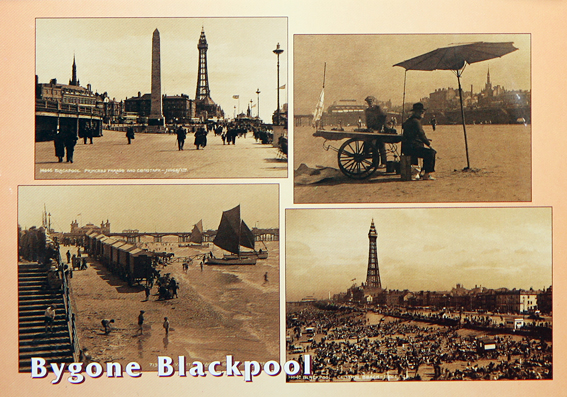
The growth of Blackpool is best understood in the context of conditions in the industrial North of England and with contemporaneous developments in communications. The history of Blackpool has been largely determined by its geographical position in relation to the heavily populated towns and cities of Lancashire, and by the rapid changes in transportation and economic conditions that took place there. The city began attracting holiday visitors in 1735, when the first guest house opened. However it was when the railway arrived, in 1846, that holidaymakers began to arrive in their thousands.
The retro postcard…
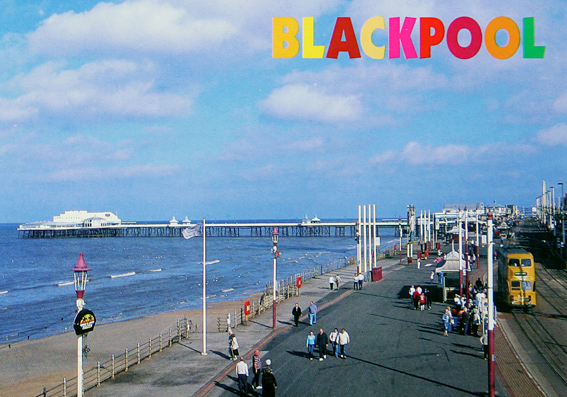
There was a practice among the mill owners of Lancashire towns to close the factories for a period every year to service and repair machinery. These became known as “wakes Weeks”. It is interesting to note that these holidays were not principally intended to give the workers a rest but were mainly to service the equipment.
The feline postcard…
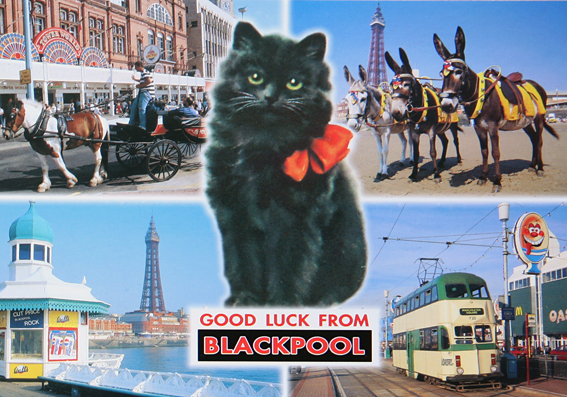
Time off work together with cheap and convenient travel led to large numbers of visitors taking their holidays outside the towns they lived in. Each town would have a different wakes week during which almost the entire population would board the trains and decamp to the coastal resorts of Morecambe, Southport, and of course, Blackpool.
The donkey postcard…

 From the 19th century, Blackpool became a popular working-class destination and it grew at a phenomenal rate. In 1881 it had a population of 14,000. By 1901 the population was 47,000. By 1951 it had grown to 147,000.Â
The humorous postcard…
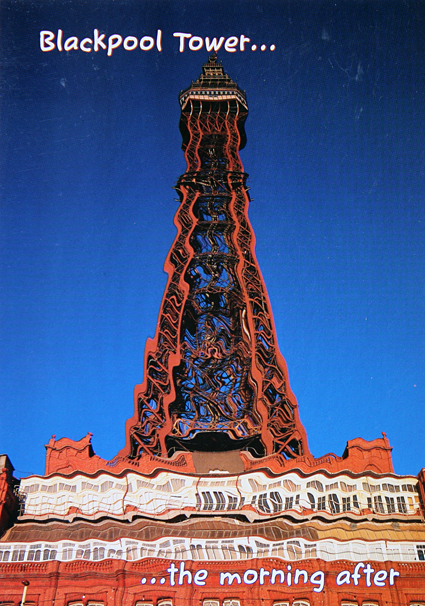
Blackpool is famous for its tower, which was built between 1891 and 1894. However, much of Blackpool’s growth and character from the 1870s on was predicated on the town’s pioneering use of electrical power. In 1879, it became the first municipality in the world to have electric street lighting, as large parts of the promenade were wired. The lighting and its accompanying pageants reinforced Blackpool’s status as the North’s most prominent holiday resort. It was the forerunner of the present-day Blackpool Illuminations.
The boring postcard…
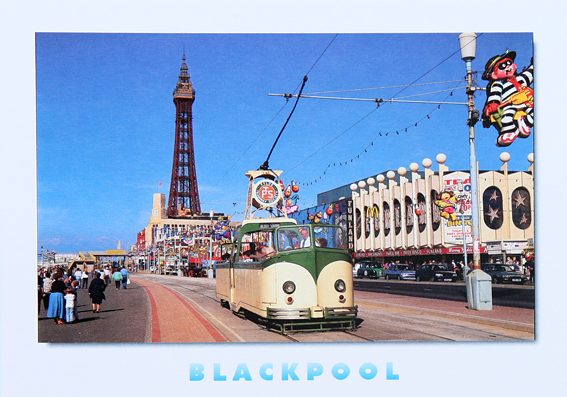
Another major development came when the post-war Labour government introduced paid annual holidays for all employees, boosting tourism in the resort. The inter-war period saw Blackpool attain pre-eminence as a holiday destination. By 1930, Blackpool claimed around seven million visitors per year, three times as many as its nearest British rivals, still drawn largely from the mill towns of East Lancashire and West Yorkshire.
One for the boys…
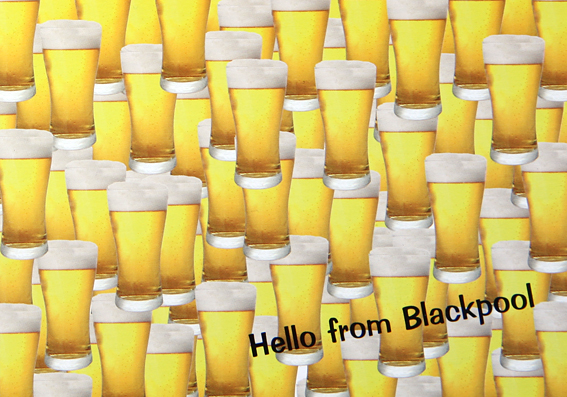
Blackpool was spared serious damage during World War II and in the decade afterwards, it continued to attract more visitors, reaching a zenith of 17 million per year. However, several factors combined to make this growth untenable. The decline of the textile industry led to a de-emphasis of the traditional week-long break. The rise of package holidays sent many of Blackpool’s traditional visitors abroad, where the weather was more reliably warm and dry, and improved road communications, epitomized by the construction of the M55 Motorway in 1975, made Blackpool more feasible as a day trip rather than an overnight stay.
My personal favourite…!
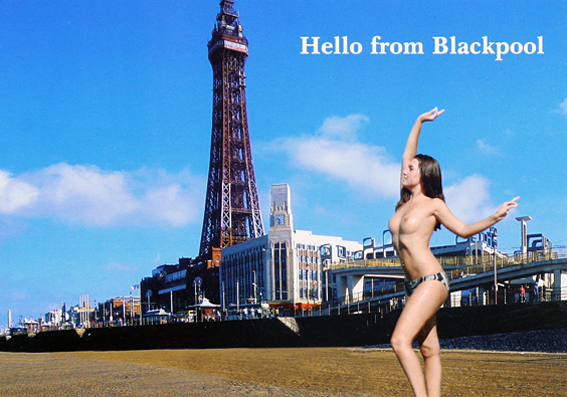
Today Blackpool’s economy remains relatively undiversified, and firmly rooted in the tourism sector. It’s a favourite location for hen and stag weekends and is Britain’s second most popular tourist attraction (over 6 million visitors a year) and was only recently knocked off the top spot by the British Museum.
Â
Posted in PLACES, POSTCARDS | Comments Off on BLACKPOOL & THE HUMBLE POSTCARD
Literally!
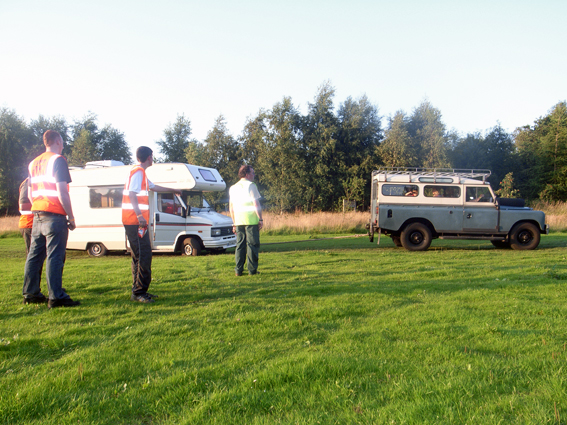
We had to be pulled out of a waterlogged field tonight after attending the Burnley Show & Hot Air Balloon Extravaganza. This is one of those examples of local tourist boards getting over excited with their marketing description – there were just two hot air balloons?! Hardly an extravaganza.
However, they did have the “Grand Finale of Burnley’s Got Talent” and a “world record attempt” by the rather fabulous John Evans, aka the Head Balancer.
“John Evans is a legendary strongman, who has delivered his own brand of unique entertainment over the pass two decades. Whose shows have astounded thousands of people. Incredibly, he balances immensely heavy objects, such as bricks and even cars, on his head.”
Here he is in action, carrying car tyres and beer crates on his head-
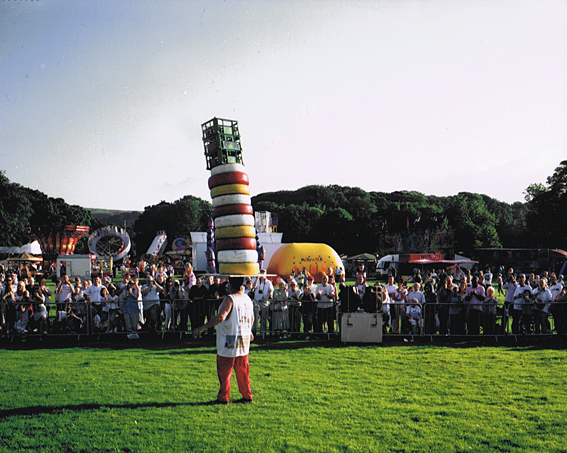
You can also watch him perform in Mansfield town centre on You Tube here and there are also some amusing video clips, including carrying a red Mini on his head, on his website here.
Posted in EVENTS & PASTIMES | Comments Off on STUCK IN THE MUD
I came across Chris Wood when hearing him interviewed on Radio 4 about his most recent album Trespasser. Wood has been established on the English folk scene for many years and he is known for his songs of English life and his uncompromising lyrical approach. I’ve been listening to the album now for a few weeks and it is contemporary and thought-provoking. As the title implies, the theme of the album is enclosure, ownership and exclusion.Â
My favourite song is undoubtedly ‘The Cottager’s Reply’ where an elderly Cotswold cottage owner talks to the rich young couple who want to pay him half a million pounds for his home.  It’s a quiet, beautiful but at the same time, angry song.Â
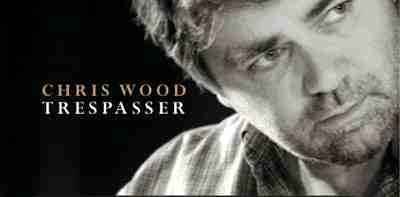
Â
Wood’s music reveals his love for the un-official history of the English speaking people. As quoted on his website–
“The people of England have been unravelling the universe through their songs, stories, poetry, jokes and dances for millennia and it is this vibrant body of work which becomes the freely given treasure trove for the next generation. The simple lesson we have learnt from our ancestors is to tell nothing more or less than our own story and that the gold we are all searching for is in our own backyard.â€â€¨
There is an interesting essay in the sleeve notes to Trespasser about what he sees as the ongoing effects of the enclosure of common land in England to the present day.
You can read a review of the album here.
28th July Update-Â Check out this article written by Chris in today’s The Times, where this quote was taken:
“What I do believe is that, like it or not, the folk song of England is a living repository of our unofficial history and is possibly the single richest cultural resource we have. It is nothing less than the collective “common sense†of our ancestors and it grants us a perspective on how we have become the people we are in a way that no other “document†can.
If that is too much of an imaginative leap, try looking across the ocean. English folk song is at the heart of the music of white America, from where it evolved to tell a large part of that nation’s story. For all that time back home in England it has been ceaselessly churning, growing and evolving.
In a media-dominated culture, where style is placed over substance, it is understandable that people just don’t get it, but as the indigenous population of this country is increasingly called upon to lay its cultural cards on the table most of us agree that “Land of Hope and Glory†and “She loves you, yeah, yeah, yeah,†don’t quite tell the whole story.”
Posted in INSPIRATION, RESEARCH | Comments Off on CHRIS WOOD- TRESPASSER
I had an enjoyable day last Friday photographing at The Open golf tournament held at Royal Birkdale in Southport. Not being a golf player or follower, it was fascinating to witness the passion with which the sport instills in its legions of fans. Just over 50,000 had turned out to brave torrential rain and gale force winds to follow some of their favourite players around the course.
Given the popularity of the sport, I suppose I shouldn’t have been surprised by the media centre (where I collected my accreditation), which was the size of an aircraft hanger. Along with the photographers and camera crews, there were literally hundreds of journalists sat behind computer screens tapping out up to the minute stories.
It was amusing walking around the course with my 5×4 camera and being greeted with perplexed glances by the golfing photography community. I was certainly the only one still using film.
I’ve always had a great deal of respect for sports photographers. I even spent a few days doing work experience alongside the talented Sports Illustrated photographer Bob Martin after winning a competition to spend two weeks photographing at Wimbledon.
Two of my favourite sport photographs are by another Sports Illustrated photographer, Neil Leifer. Both photographs are of Muhammad Ali from the 1960s and the first was taken during Ali’s bout against Cleveland Williams at the Houston Astrodome on November 14, 1966.
Â
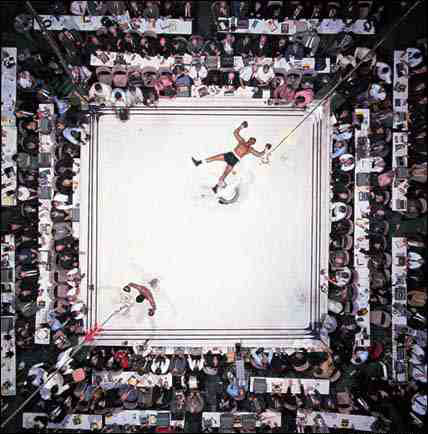
© Neil Leifer
Â
The second was taken on May 25, 1965, when Ali stopped Sonny Liston with one punch in the first round of their heavyweight championship fight in Lewiston, Maine.
Â
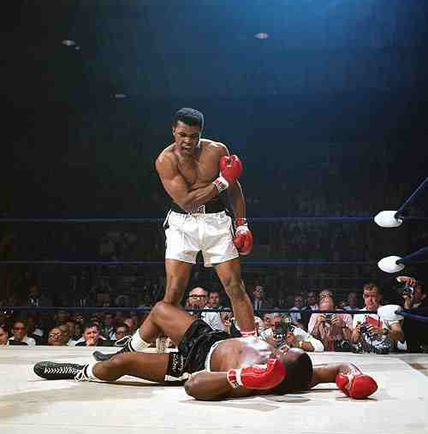
© Neil Leifer
Â
They are both extraordinary images. One of the things that strikes me most looking at them over forty years later is the absence of any advertising branding, which gives the photographs such purity.
Here is a quote from Leifer taken from Digital Journalist where he describes both pictures-
“Part of being a great photographer is being lucky enough to be in the right spot at the right time like I was, but a more important part is not missing when you’re in that spot. I got very lucky at the Ali-Liston fight, but what I’m proudest of is that I didn’t miss. It’s always assumed that the Ali-Liston picture is my favorite. Not so–I took my all-time favorite picture at another Ali fight one and a half years later. Photographers had mounted cameras on the light rigging above the ring before, only they had pointed them down, from the corners, so that they could capture the fighters’ facial expressions. Because the lighting rig was usually only about 20 feet above the canvas, even the widest of wide-angle lenses wouldn’t allow you to capture the whole ring. But the Ali-Cleveland Williams fight was in the Astrodome, where for the first time, the rig would be about 80 feet up, so it wouldn’t block the sightlines of spectators in the upper deck. I realized at that height, you could get the entire ring in the picture, and that it would be perfectly square. Ali-Williams is my personal favorite picture, but I know that 100 years from now, Ali-Liston is the one picture that everybody will remember me by.”
You can read a longer interview with Leifer written in 2002 here.Â
Â
Posted in EVENTS & PASTIMES, MISCELLANEOUS | Comments Off on SPORTS PHOTOGRAPHY
I mentioned research published by Professor Danny Dorling in an earlier post last week. One of his colleagues, Professor Nicky Gregson, who also happened to be my university tutor, has conducted extensive studies into the social phenomenon of the car boot sale. Having just been to the Chelford car boot I thought it might be of interest to post up some of her research findings – especially as over a million people enjoy haggling and finding curious, useful and sometimes (in)valuable items at car boot sales every weekend.
Professor Gregson was one of the first people to do academic research into these events, exploring the car boot as marginal spaces of contemporary consumption. Her various studies were conducted alongside Louise Crewe of Nottingham University and you can see abstracts from their research papers here, here and here.
Their research found that the most popular buys were children’s clothes. Items bought to “sell on” included clothes and equipment for babies, videos, kitchen utensils and DIY tools. The maximum number of purchases by a consumer recorded was 94 and the most spent was £100. Far from being the poor and unemployed, 40 per cent of buyers were employed; 16 per cent in part-time work and 21 per cent retired. Two-thirds of the comsumers surveyed were aged 25-55 and men and women were found to be fairly evenly represented at the sales. Women typically bought and sold children’s clothes, toys, ornaments and household goods with men showing greater interest in things such as DIY equipment, gardening tools and car accessories and parts.
You can find out more about Gregson’s recent research into ‘Disposal, Devaluation and Consumerism’ here.
And if you’re looking for a car boot near you, visit www.carbootjunction.com.
Â
Posted in EVENTS & PASTIMES, RESEARCH | 1 Comment »


















